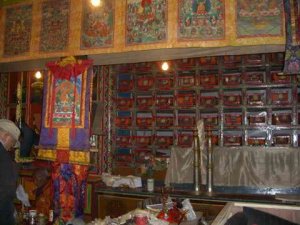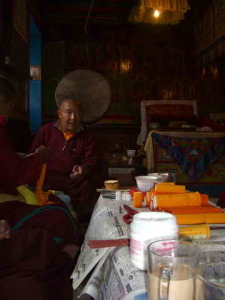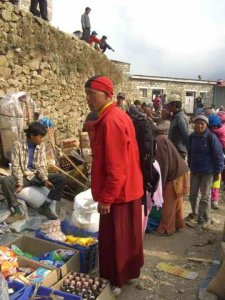In Namche Bazaar, clouds throw themselves over the steep mountain tops like crocheted shawls. But when it gets dark, it’s dark. As exhausted as I was after trekking to Namche Bazaar, even to eating dinner in my room, even warm under a duvet and a sleeping bag, even fading quickly when I tried to read Follett’s novel, sleep came like smoke signals, sometimes si, sometimes no. Dogs chanted the night away. The night seemed long until the hounds quieted and the crows, big as dac hshunds, were the only fowl music, as was the early workmen chipping masses of round stones – clink, clink, clink- to make them rectangular. There is a lot of construction in progress in this pueblo. Jeta arrives at my door with a cup of hot instant cappuccino. I could get used to this.
hshunds, were the only fowl music, as was the early workmen chipping masses of round stones – clink, clink, clink- to make them rectangular. There is a lot of construction in progress in this pueblo. Jeta arrives at my door with a cup of hot instant cappuccino. I could get used to this.
I get the courage to leave the warmth to test if hot water comes in the shower. I let the sink water run until it turned hot. That was a good sign. So I finally got a full-fledged cleansing shower in hot water. That gave me a new lease on life. And because we don’t have to trek today as we acclimatize, I put on my favorite old trousers, my big black baggy sweater, and a huge cotton scarf. I’m going to attempt to recreate a slice of my comfort zone, at least in the morning. Breakfast was a buckwheat apple pancake with the thickness of three pancakes. Good for a tempestuous spirit breaking the rules of her diet.
After a morning on the computer and a splendid grilled cheese, tomato and spinach sandwich lunch, Jim thought it would be good to stretch the legs. I felt good and said let’s go. We’d hike up to the top of the town and around to the other side of the mountain to visit a gom pa (Buddhist temple) which was in the process of celebrating the arrival of a new statue of Guru Rinpoche, who centuries ago declared the Khumbu Valley would be a sanctuary from the world; then we’d head to the bazaar for which this town is named. It’s a weekend event that brings locals from as far as a seven day walk to sell their harvest and supplies. It would be a good photo op..
pa (Buddhist temple) which was in the process of celebrating the arrival of a new statue of Guru Rinpoche, who centuries ago declared the Khumbu Valley would be a sanctuary from the world; then we’d head to the bazaar for which this town is named. It’s a weekend event that brings locals from as far as a seven day walk to sell their harvest and supplies. It would be a good photo op..
Grabbing my sticks, I set off up these endless wide stone stairs – hardly had I gone up two and I was winded, my heart started beating fast, and I got discouraged because I realized I still had a way to go before my lungs were ready in this high altitude (11,000 feet.) Darn it. I thought. We took it slowly, very slowly, pacing me, ascending step by step as I broke out in a sweat under my warm jacket. I had wrapped myself in the big cotton scarf for protection against the dust. There was a brisk cool breeze as well. Finally we circled the entire city passing red rhododendron trees and giant boulders carved with the Om and painted white, then arriving, after some complicated step work, at the yellow roofed gompa. More high steps up through the entrance, I felt dizzy, then we removed our hiking shoes to pay respect to a holy place. This old gompa had fallen into disrepair and the community had come together with offerings of every sort (grains, coins, kata scarves for good luck and rolled sheets of prayers covered in ochre fabric) which were being organized to be kept in the large base of the statue. I guess it is sort of like leaving food and eternity entertainment in tombs of Egyptian Pharaohs. The gompa items are never removed from the statue’s base. Village women had brought huge vats of hot tea, and one elderly monk was about to indulge in a grilled cheese sandwich. Right on.
cool breeze as well. Finally we circled the entire city passing red rhododendron trees and giant boulders carved with the Om and painted white, then arriving, after some complicated step work, at the yellow roofed gompa. More high steps up through the entrance, I felt dizzy, then we removed our hiking shoes to pay respect to a holy place. This old gompa had fallen into disrepair and the community had come together with offerings of every sort (grains, coins, kata scarves for good luck and rolled sheets of prayers covered in ochre fabric) which were being organized to be kept in the large base of the statue. I guess it is sort of like leaving food and eternity entertainment in tombs of Egyptian Pharaohs. The gompa items are never removed from the statue’s base. Village women had brought huge vats of hot tea, and one elderly monk was about to indulge in a grilled cheese sandwich. Right on.
The gompa is rather dark but every piece of wall space is covered in glittering fabrics, repetitive block prints and thangkas (holy art) as well as one long wall, a glass cabinet of sort, contains 108 ancient books of Buddhist wisdom from which the monks constantly read. The statue will be placed in the middle of the books. Much of Buddhist art is in block prints, which the lamas give to the villages. These are printed on par-shing, wooden blocks carved with the reverse ima ge of the print. These blocks are also used to make prayer flags. Each image has a function: Ku-par are pictures of gods and historic figures; Srung-par are protective prints worn in bags around a person’s neck or put on the door knob of a house; Lok-par, mostly commonly evil eyes images, are burned during ritual exorcisms; Others are used as prayer flags, displayed at weddings or placed under a dying person’s body about to be cremated. Then there are Mandalas which are geometric art works symbolizing order and harmony and used for meditation much like religious icons are used in catholic churches. Some Mandalas are made in colored sand.
ge of the print. These blocks are also used to make prayer flags. Each image has a function: Ku-par are pictures of gods and historic figures; Srung-par are protective prints worn in bags around a person’s neck or put on the door knob of a house; Lok-par, mostly commonly evil eyes images, are burned during ritual exorcisms; Others are used as prayer flags, displayed at weddings or placed under a dying person’s body about to be cremated. Then there are Mandalas which are geometric art works symbolizing order and harmony and used for meditation much like religious icons are used in catholic churches. Some Mandalas are made in colored sand.
A  dip down into this layered village took us down a lane of tourist shops (good mountaineering gear can be found here) where I found a skein of colorful yarn for my crocheting and also some much needed gloves (ski gloves are too big for daytime warmth.) The market having just begun in the afternoon, was a bustle of trading. Big white sacks of flour, of Dak (white beans, bla
dip down into this layered village took us down a lane of tourist shops (good mountaineering gear can be found here) where I found a skein of colorful yarn for my crocheting and also some much needed gloves (ski gloves are too big for daytime warmth.) The market having just begun in the afternoon, was a bustle of trading. Big white sacks of flour, of Dak (white beans, bla ck beans) of a kind of flattened rice that is great in muesli, giant tins of fresh cottage cheese which I was eager to sample, but Jim said not to; every kind of hot spicy pepper, turmeric by the tons, baskets of live chickens, eggs that were small by our standards but fresh, and many packaged goods. Sherpa women with dark faces and rosy cheeks drive a hard bargain and sit among the large sacks. This is serious merchandise, not the usual tourist fare of beaded necklaces, bandanas o
ck beans) of a kind of flattened rice that is great in muesli, giant tins of fresh cottage cheese which I was eager to sample, but Jim said not to; every kind of hot spicy pepper, turmeric by the tons, baskets of live chickens, eggs that were small by our standards but fresh, and many packaged goods. Sherpa women with dark faces and rosy cheeks drive a hard bargain and sit among the large sacks. This is serious merchandise, not the usual tourist fare of beaded necklaces, bandanas o f every sort, clothing and trinkets which are laid out along the narrow passageways of the town.
f every sort, clothing and trinkets which are laid out along the narrow passageways of the town.
As we climbed our way back up to our Panorama Lodge, I took it one step at a time. I wonder how foolish I look to the Sherpas and young tourist (there was a whole load of youngsters from New Zealand just fallen into the large dining room, who were going only to Tengboche a day away) as sweat drips off my forehead and I keep my eyes on the stone so as not to cause a wreck. 
Lakpa, a beautiful Sherpa woman who owns the lodge in which we stay, joined us for tea and showed us original Thankas created by her cousin. She has been the subject of a book on Sherpa customs and has traveled extensively in the US. Today Jim and the cook made potato salad American style (mayo, mustard, capers, eggs) which really lifted up my sagging appetite. I have to admit they were they were the best potatoes I’ve ever tasted. Jim had warned me. r
Photos: View of Namche Bazaar; Inside a gompa; rolling Buddhist prayers; woman selling cottage cheese at the Bazaar; Vendor of spices and yeast; Sherpa woman; a young monk; Tea with Lapka, the Sherpa owner of our lodge.
